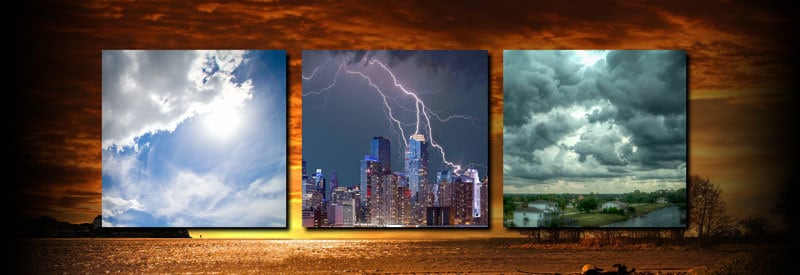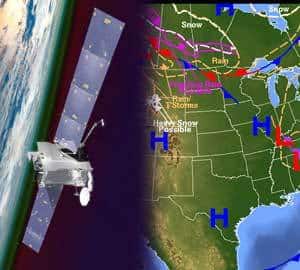What Causes Weather To Change, Change So Quickly, And Can It Be Predicted?

We all get upset with weather forecasters when they "get it wrong," and our plans are completely ruined. A "sunny weekend" at the beach is spent staring at the pouring rain through your cabin window.
But if you are honest with yourself, depending on where you live, you may already be well aware of how often and quickly the weather can change.
This still leaves us with a few questions:
- What causes the weather to changes?
- Why does the weather change so quickly?
- How quickly can a weather forecast change?
The best way to answer these questions is to start at the beginning and first identify why weather change takes place in the first place and what factors are involved. We can then examine why it can change so quickly and whether these changes can be predicted.
What Causes Weather To Change?

Changes in weather are primarily the result of a change in temperature, air pressure, and humidity in the atmosphere. When any of these three variables experience a substantial change, it can lead to a complete change in weather conditions.
Other variables also play a part in weather formation, but when existing atmospheric conditions change, these three factors have the biggest influence.
For example, a sudden drop or rise in temperature can cause a significant contrast in the air pressure of neighboring air masses, which can result in strong and gusty winds. (As air always flows from an area of high to an area of low pressure.)
Also, when the atmospheric pressure changes into a high-pressure system, it can lead to clear and sunny skies. On the other hand, when air pressure drops and turns into a persistent low-pressure system, it can lead to heavy cloud formation and precipitation.
You can read more about how air pressure works, how it is formed, and the different types of weather created as a result in this article.
Now that the causes of weather changes have been identified, it is still not clear why these changes can occur so quickly in some areas.
Why Does The Weather Change So Quickly?
There are literally dozens of reasons why you may be experiencing unpredictable and fast-changing weather in your area. However, three factors have been identified that always contribute to erratic atmospheric conditions:
- Situated in a temperate climate zone.
- Located in a coastal region.
- A flat topography characterizes the region.
All three factors can cause erratic fast-changing weather separately, and to better understand how we need to look at each one individually.
1) Temperate Climate Zone
Of the three major climate zones, the temperate zone is caught between the warm weather from the Tropics and cold weather from the polar regions.
Depending on the strength of a weather system, cold air from the polar region will move into a temperate region, causing temperatures to plummet. It can just as quickly be forced to retreat when a stronger weather system from the tropics moves into the same area.
As a result, it is possible for a region to experience freezing and stormy weather at one moment, only to be replaced by warm and clear weather a few hours (or a day) later.
A few cities across the world-famous for their unpredictable weather, are situated in temperate climate zones. They include Denver (Colorado), Birmingham (England), and Chicago (Illinois).
2) Coastal Region

When you live in a coastal region, the prevailing winds play a huge part in changes to the weather. The land and sea heat up and cool down at different speeds, causing a difference in temperature to develop quickly. (Land warms up and cools down faster than the ocean.)
Depending on the strength of the difference in air pressure, the result is a strong sea breeze during late afternoons and evenings or a land breeze during the night and early mornings.
These regions not only experience constantly changing winds, but also the accompanying weather systems they blow into the area from either inland or over the ocean. This combination makes the weather conditions in a coastal region even more unpredictable.
3) Flat Topography
The role of topography in the formation and behavior of weather is often underestimated. It can be responsible for the presence (or lack) of certain weather conditions, as well as influence the speed and duration of a weather system.
It is the latter that comes into play when it comes to rapid-changing unpredictable weather. Where a mountainous terrain may slow down or even allow weather conditions to die down, a flat terrain allows weather systems to pass through freely and uninhibited.
As a result of the fast-moving weather, the cold front you are experiencing right now can be replaced by a warm front and clear skies in a matter of hours. You may even be confronted by a completely different set of weather conditions by the end of the day.
In a region with flat topography, especially in temperate climate zones, it is only the speed of the winds that drive the weather that will determine just how erratic the weather will be.
Even though any of these locations can promote unpredictable fast-changing weather, some regions are exposed to all three of them, creating the ideal recipe for some erratic behavior. Sydney and Melbourne in Australia are two perfect examples of such locations.
Can A Weather Forecast Predict Erratic Weather
The short answer to this question is both yes and know. The explanation, though, is a bit more complicated and depends on your definition of fast-changing unpredictable weather.

Weather services have become very accurate and able to adjust predictions to weather much more quickly over the years. This is mainly due to improved forecasting models, advanced sensing technologies like radar, and more computing power.
This means the weather can not only be predicted with more accuracy further into the future, but quicker and more precise updates allow forecasts to adjust to sudden changes in atmospheric conditions. There are limitations, though.
Forecasters can "catch" weather changes much quicker but are not yet able to detect every possible variable or unforeseen factor. It will be fair to say that a good weather service can make accurate and "adjusted" forecasts up to a maximum of roughly six hours.
(Weather doesn't like to be told what to do, so even this rough estimate may sometimes be completely wrong due to some unexpected intrusions.)
Also, take into consideration that there are "pockets" in a forecast region that are unique to your area. Even though the forecast for a location will be dead accurate, you may be located in a valley or behind a hill that causes you to experience very different conditions.
In summary, weather services are accurate and do compensate for weather changes. Unforeseen circumstances can still interfere, though, as well as your own location that may always experience different weather than anyone ten minutes drive away.
(The reason I use a home weather station to make sure I stay updated about the atmospheric conditions in my immediate surroundings. If you are interested, you can read more about the advantages of a home weather station here.)
Conclusion
This article highlighted the primary reasons to help one understand why weather changes and changes so quickly. You will also have a good idea of the extent to which these changes can be forecasted.
As you would have noticed, nothing is set in stone. The causes of weather changes vary, and we only know some of the factors influencing it. The same goes for weather forecasts. They can be dead accurate but still miss the mark due to some unforeseen last-minute gremlin.
The only thing that is certain is that the weather will always be unpredictable, and no matter how good meteorologists get, they will always be playing catch-up. So next time you want to get angry about an inaccurate forecast, spare a thought for the meteorologist.
Never miss out again when another interesting and helpful article is released and stay updated, while also receiving helpful tips & information by simply clicking on this link .
Until next time, keep your eye on the weather!
